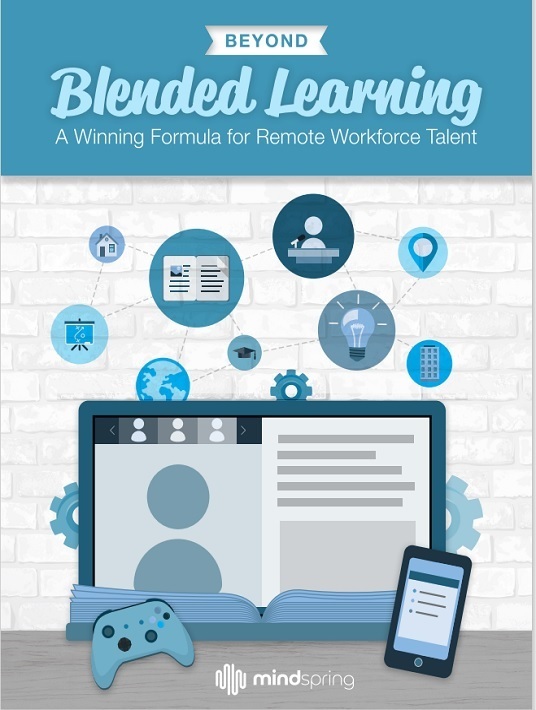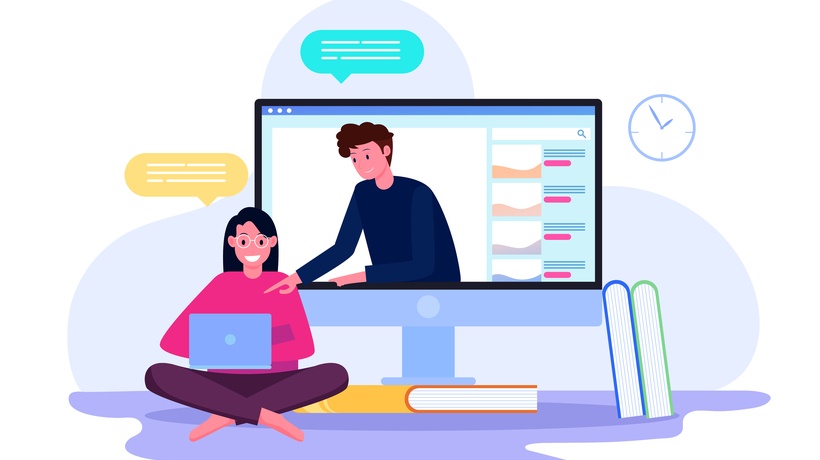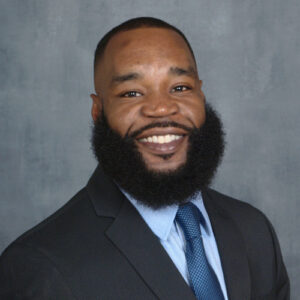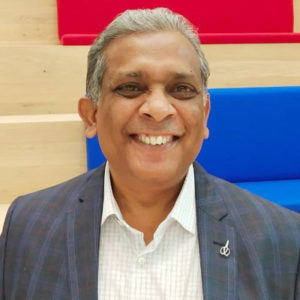Which Blended Learning Design Elements Are Best For Your Teams?
This article is part of a series exploring the concept of blended learning for remote and on-site workers. What you are about to read is a fable. The company, AshCom, is fictional but the learning challenges faced by Kathryn, AshCom’s CLO, and her team are real and commonly shared by learning teams in large organizations. It is our hope that you will be able to connect with the characters, their challenges, and the solutions they discover. We also invite you to read the first eBook in the series.

Two Learning Challenges
AshCom’s two significant learning challenges were driven by two factors beyond their control. The first had to do with what is commonly known as the “skills gap.” If you have not yet faced it in your industry, chances are you soon will. As a large manufacturer, AshCom saw the gap become apparent more quickly than some other industries, but the gap is appearing across all sectors of the global economy.
The causes of the skills gap are multiple. In some nations, it is created by demographics in which more people are retiring than are entering the workforce, leading to fewer new workers which create the gap. The skills are missing because the people are missing. But it should not be considered a demographic problem entirely. Global competition means that companies are increasing the number and sophistication of technology solutions in offices, in the field, and in factories around the world. Every company is looking for more efficient means of doing their work or providing their services because they are often competing against firms like themselves in lower-wage regions of the world. Their solution is often automation. This may lower the number of people needed, but it will increase the skills that are needed to oversee what machines can do. Even if many more people entered the workforce, this alone would not solve the challenge because the skills needed are not present in the people available.
The numbers are sobering. In manufacturing alone, as many as 2.1 million jobs will remain unfilled by 2030 according to a recent study by Deloitte. Seventy-seven percent of manufacturers are currently struggling to attract and retain the people they need. Manufacturing, however, is not alone in this struggle.
AshCom’s second challenge was the growing call among potential and current employees to work remotely part or all of the time. This has been in the wind for several years. COVID did not create this demand, but it has certainly increased the number of people requesting remote options even as facilities and companies are again opening for in-person work. This trend will continue for the foreseeable future and will likely increase as organizations figure out how to effectively have team members who are not on their property for most or all of their workday.
Working Remotely
The increasing call for remote work will increase the need for effective learning experiences for people working remotely. The solution cannot be simply converting existing training material to some sort of online modality. It will require more thought and planning if remote learning experiences are going to deliver what organizations and learners need.
Darryl, one of the learning team members at AshCom, believed he had an answer: blended learning (BL). He began optimistically that BL would resolve the challenges faced by his peers. His team had created some blended learning in the past, and it seemed to work well. But the further he dug into it, the more he concluded that the concept of blended learning was leading him to a dead end. The term lacked definition despite his digging into the research available.
Darryl’s journey led him to a discussion with Rebecca from Inno-Versity, a company that takes the best of learning science, creativity, and technology to come up with the best learning solution. Rebecca had already been down the path Darryl was on. She long ago had come to the same conclusion that blended learning might not be a helpful concept. At least at the beginning of the process. To her, it made little sense to begin to solve learning problems by determining ahead of time that a blended approach might be the best approach.
Blended Learning Design Elements: The Formula
Rebecca shared with Darryl a simple formula for approaching learning problems: N1+N2+T+D=M.
N1 = Needs of the organization
N2 = Need of the learners
T = Tools available
D = Design
M = Modality
Rebecca and Darryl worked their way through this formula as it related to the two big learning challenges of AshCom. Eventually, they shared their discussion with the entire learning team at AshCom and they decided to approach their problem from the perspective of the formula. They stopped thinking about whether the learning would be blended. They decided they would know at the end of the process whether their learning contained two or more learning modalities but by the time that occurred, they would no longer care much about whether something was blended.
This entire eBook is about putting the concept of blended learning to rest. It should not be an objective. It might be a result, but the needs of the organization and the learners need to be considered first. Other starting points will lead to less than ideal results.
Once both needs are clear to all involved, the tools available to your team should be considered. These may be tools you already possess or tools you need to add to your learning toolbox. Match the needs to the tools and plan out the way you will acquire and master the tools that are needed. Once these steps are taken, enter the design phase of storyboarding and concept creation.
The result will be the best learning experience possible given what you know about your organization’s learning needs, the needs of the learners, the tools you have, and your very best design work. Will it be blended? Probably, but consistent with the experience of Darryl and the AshCom learning team, it likely won’t matter very much to you.
Epilogue
AshCom did take this approach to the challenges of the skills gap and the growing desire for remote work among potential and current employees. They spent significantly more time considering the needs of their company and the needs of their learners than they had with previous learning experiences. Part of this was frustrating to some on the team because they were used to gliding quickly through the needs analysis part of the process and moving to the beginning of the creative process. Others on the team thought the deliberation was warranted and would give better, deeper, and more enduring learning experiences to the employees of AshCom. The result was that by spending more thought and time with N1 and N2, their direction became clearer faster than it had ever before. To quote a good friend of mine, they slowed down to speed up.
The T or Tools section of the process was also a little frustrating at first. The learning team had a habit of choosing one or two authoring tools even though they had many available. They attributed this to simply being able to move faster with the tools they used all the time than with those less familiar to them. As they followed the N1+N2+T+D=M process, they were forced to decide which tool(s) to use instead of working based on habits. They also began to create a list of tools they would like to master in the coming months. Augmented and virtual reality were part of that list as they had little experience in either, but they also decided to explore new authoring options to increase the size of their toolbox.
By the time they got to the Design (D) part of the process, they were able to speed up significantly. In a few instances, they changed courses and chose a different tool. Twice, they had to revisit the needs of the learners to make sure they were heading in the right direction.
The result was blended learning. They created a series of learning experiences to attract and retain talented people. The blend was a combination of in-person experiences. For some, that meant newly retired expertise mentoring newly employed younger people. There were many digital options. Some learning experiences were created to be highly flexible so that learners could toggle between the modalities of a single learning experience.
The further they got into development, the more they came to learn that the gap between what AshCom needed as a company, what the learners wanted, and the learning experiences were delivering narrowed. People were getting what they needed when they needed it and in a variety of modalities.
The Wrap-Up Meeting
As you know from reading this eBook, the original people involved in bringing these two challenges to the attention of the learning team were Lazlo, AshCom’s Chief Human Resources Officer, and Akihiko, its Chief Operating Officer. Several months after the new learning experiences began to roll out, Lazlo and Akihiko asked to meet with Kathryn, AshCom’s Chief Learning Officer.
Kathryn knew both well but was anxious about the meeting. She had been tracking the learning progress across the entire company after the rollout of the new approach. In preparation for the meeting, she gathered some statistics and some success stories in case she was asked to give a defense of what was happening inside the learning culture of AshCom.
All of her anxiety melted away when Lazlo and Akihiko began the meeting by handing her and her entire team premium tickets for the Minnesota Symphony Orchestra as an expression of their thanks for the incredible work they had done.
As Kathryn held the tickets in her hand, she sheepishly said, “Not that I’m not grateful. But I have two requests.”
“Shoot,” said Lazlo.
“Some of my learning team might want to trade symphony tickets for some other concert,” replied Kathryn.
Lazlo and Akihiko laughed out loud. “Too highbrow or not highbrow enough?” asked Lazlo.
“I don’t think I can answer that,” said Kathryn with a smile. “But would it be OK with you if I asked them about a concert we can attend together?”
“Of course,” said Akihiko. “Make it the concert of your choice. We can always find people to go to the symphony. And the second request?”
Kathryn responded, “Although she isn’t formally an employee of AshCom, I would like to include Rebecca from Inno-Versity. Our entire approach to solving remote work and the skills gap began with a formula she gave us, and she needs to be part of this.”
“That is entirely your decision,” said Lazlo. “We certainly don’t know everything that went into what you’ve built, but we just want you to know that it is doing just what we asked of you months ago.”
Conclusion
Download the eBook Beyond Blended Learning: A Winning Formula For Remote Workforce Talent to discover how AshCom overcomes its L&D challenges using innovative blended learning strategies. Also, join the webinar to uncover valuable insights that will help you improve your L&D planning and learning delivery.










